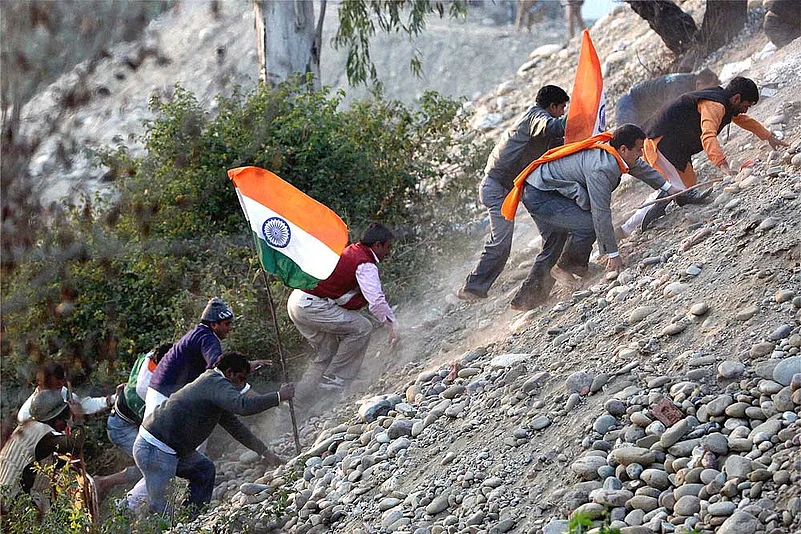The unprecedented majority gained by the BJP in the recent elections has made some people wonder whether India is on the road to becoming a Hindu majoritarian state. There is nothing in the bjp’s manifesto to justify such fears. But past provocations by Subramanian Swamy and more recent ones by Ashok Singhal (Hindustan Times, July 17) do make the question worth debating. The hope reportedly expressed by a Goa minister (belonging to a coalition partner) that India could become a Hindu rashtra under Narendra Modi (Times of India, July 25) does make the question worth debating. While there can’t be any doubt that the Hindutva agenda will be steadfastly pursued, is it constitutionally possible to make India a Hindu rashtra?
To do that, we will have to start right with the Preamble to the Constitution. We will have to drop the words “secular” and “democratic” from the description of the Republic. The words “justice, social, economic and political” will have to be deleted. “Liberty of thought, expression, belief and worship” will have to be dumped. “Equality of status and of opportunity” will have to be erased. And we must even abandon “fraternity, assuring the dignity of the individual and the unity and integrity of the nation”.
After ripping the Preamble apart, we will need to storm the Fundamental Rights. The essential targets will be nine. Equality before the law and equal protection of the laws (Article 14). Prohibition of discrimination on grounds, inter alia of religion (Article 15). Equality of opportunity in matters of public employment (Article 16). Freedom of conscience and free profession, practice and propagation of religion (Article 25). Freedom to manage religious affairs (Article 26). Freedom from payment of taxes for promotion of any religion (Article 27). Bar on religious instruction in any educational institution wholly maintained out of state funds, and freedom not to attend religious instruction or worship in state-recognised or partly state-aided educational institutions (Article 28). And the cultural and educational rights of minorities (Articles 29 and 30).
But this is where the “basic structure doctrine” comes in. In 1967, the Supreme Court ruled in Golak Nath’s case by a thin majority that the power of Parliament to amend the Constitution was not unlimited, and that any amendment which took away or abridged fundamental rights would be void. Remember, Indira Gandhi was still finding her feet then. In 1971, a very powerful Indira Gandhi responded to the Golak Nath judgement by bringing in the 24th Amendment, which removed all restrictions on Parliament’s amending power. And a bench of 13 judges of the Supreme Court (the largest ever) sat to decide the Kesavananda Bharati case (involving the validity of that amendment, and consequent and related amendments).
Again, by a slender majority (seven against six), the Supreme Court ruled in April 1973 that the power of Parliament to amend the Constitution did not extend to altering its basic structure or framework. The perceptions of the different judges on what would constitute the basic structure were not uniform. They gave illustrative lists. Chief Justice Sikri’s list included a democratic form of government (remember, a system which marginalises sections of its citizens can never be democratic), the secular character of the Constitution and the dignity and freedom of the individual. Justices Hegde and Mukherjea said: “Unlike in most of the other Constitutions, it is comparatively easy in the case of our Constitution to discern and determine the basic elements or the fundamental features of our Constitution: for doing so, one has only to look to the Preamble.” The secular character of the State found echo in the judgements of Justices Grover, Shelat and Khanna as well. Justice Jaganmohan Reddy emphasised social, economic and political justice, liberty of thought, expression, belief, faith and worship and equality of status and opportunity.
There was just one abortive Emergency-time attempt by the Indira Gandhi government to get the Supreme Court to review the Kesavananda verdict. Since then, the political class has accepted the “basic structure” doctrine; it is now 41 years old. Any attempt to tamper with the Constitution will be hit by the doctrine, and will not withstand judicial scrutiny. However, if a determined government decides to enact a Uniform Civil Code, a different yardstick may have to be applied. The government may be able to argue that Article 44 (a Directive Principle) requires it to endeavour to secure for citizens a uniform civil code.
And now, a disclosure. I have been a critic of the “basic structure” doctrine on the ground that it is anti-democratic and counter-majoritarian (a different kind of majoritarian, referring to parliamentary supremacy).
I have argued that unelected judges should not have the power to interfere with the authority of elected representatives to decide what the Constitution should be. In an essay written 14 years ago, I have, without prejudice to my critique, acknowledged the importance of Kesavananda in the context of its times: it warned a fledgling democracy of the perils of brute majoritarianism. I concluded on a naive note: “Those days are however gone. Coalitions can only bring about major changes through consensus. The doctrine must now be buried. The nation must be given an opportunity to put half a century’s experience of politics and economics into the Constitution.” Now that majority politics has returned, is a rethink necessary?
(The writer is a senior advocate of the Supreme Court, and a former additional solicitor-general.)
















